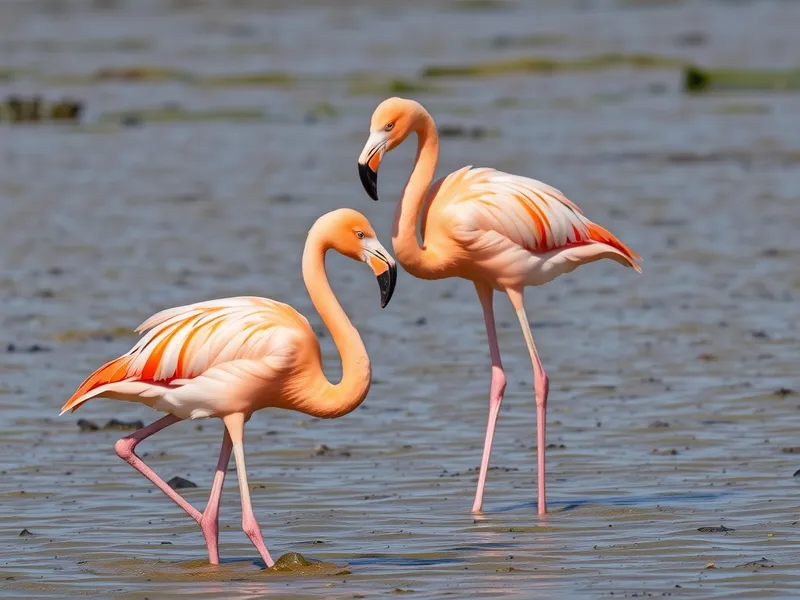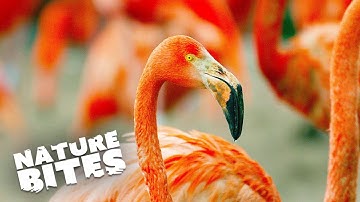
American Flamingo
Phoenicopterus ruber

Meet the American Flamingo
The American Flamingo is a striking wading bird known for its vibrant pink to reddish plumage, long legs, and distinctive downward-bending bill. Native to the Caribbean, northern South America, and the Galápagos Islands, it thrives in saline lagoons, mudflats, and shallow coastal lakes. Its unique coloration comes from carotenoid pigments in its diet, primarily from algae and small crustaceans. American Flamingos are highly social, forming large colonies that can number in the thousands, and they are renowned for their synchronized courtship displays.
Classification
Bird
Habitat
Shallow saline lagoons, mudflats, and coastal lakes
Diet
Omnivore
Lifespan
20-40 years
Conservation
Least Concern
Weight
2-4 kg
📖Fascinating Facts
Pink from Diet
The vivid pink or reddish color of the American Flamingo comes from carotenoid pigments in the algae and crustaceans they eat.
Chick Development
Flamingo chicks hatch with gray or white down and only gradually acquire their pink coloration as they consume pigment-rich food.
Colony Behavior
American Flamingos are highly social, often nesting and feeding in colonies that can number in the thousands, which helps protect them from predators.
📋Detailed Description
The American Flamingo (Phoenicopterus ruber) is a large, charismatic wading bird distinguished by its vivid pink to reddish plumage, which is the result of carotenoid pigments derived from its diet. Adults typically stand 120–145 cm (47–57 in) tall and weigh between 2–3 kg (4.4–6.6 lbs), with males generally being slightly larger than females. The species possesses long, stilt-like legs and a uniquely shaped, downward-bending bill adapted for filter feeding in shallow, saline waters. Their wingspan ranges from 140–165 cm (55–65 in), and flight feathers are black, contrasting with the rest of the plumage. The eyes are pale yellow, and the legs are pink, often with a darker 'knee' joint. Juveniles are grayish or white, gradually acquiring adult coloration over 2–3 years. American Flamingos are highly gregarious, forming colonies that may number from several hundred to over 10,000 individuals. These colonies provide safety in numbers and facilitate complex social behaviors, including synchronized courtship displays. Their vocalizations are loud, honking calls used for communication within flocks. The species is native to the Caribbean, northern South America, the Yucatán Peninsula, and the Galápagos Islands, inhabiting saline lagoons, mudflats, and coastal lakes where few other birds can thrive.
💡 Did you know?
Despite their tropical appearance, American Flamingos can tolerate surprisingly cool temperatures and have even been seen feeding in chilly waters.
🔬Research & Sources
Wikipedia Summary
The American flamingo is a large species of flamingo native to the West Indies, northern South America and the Yucatán Peninsula. It is closely related to the greater flamingo and Chilean flamingo, and was formerly considered conspecific with the greater flamingo, but that treatment is now widely viewed as incorrect due to a lack of evidence. It is also known as the Caribbean flamingo, although it is also present in the Galápagos Islands. It is the only flamingo that naturally inhabits North America along with the Neotropical realm.
Last Modified: 5/24/2025
🎭Behavior & Social Structure
American Flamingos are diurnal and spend much of their day feeding, preening, and engaging in social interactions. Their feeding behavior is highly specialized: they wade through shallow water, submerging their bills upside-down and using a unique filter-feeding mechanism. Lamellae (comb-like structures) in the bill trap algae, diatoms, small crustaceans, and other microscopic organisms. Flamingos often feed in groups, stirring up the substrate with their feet to dislodge food. Socially, they are among the most gregarious of birds, forming large, stable colonies that facilitate breeding and predator avoidance. Synchronized group displays, involving head-flagging, wing-saluting, and marching, are crucial for pair formation and maintaining social cohesion. Preening is frequent and essential for maintaining feather health, aided by uropygial gland secretions. Resting is typically done standing on one leg, which may help conserve body heat.
👶Reproduction & Life Cycle
Breeding is highly synchronized within colonies and often triggered by seasonal rains that increase food availability. Courtship involves elaborate group displays, after which monogamous pairs form for the season. Both sexes participate in nest building, constructing a conical mud mound above the waterline. The female typically lays a single chalky-white egg, which is incubated by both parents for 27–31 days. Upon hatching, the chick is covered in gray down and is fed a nutrient-rich 'crop milk' produced by both parents. Chicks leave the nest within a week to join crèches (nursery groups), but continue to be fed by their parents for up to two months. Fledging occurs at 65–90 days, but full adult plumage and independence are not achieved until 2–3 years of age. Breeding success is highly variable and depends on environmental conditions and colony stability.
🛡️Adaptations & Survival
The American Flamingo exhibits several remarkable adaptations for its saline and alkaline wetland habitats. Its specialized bill and tongue allow efficient filter feeding on small aquatic organisms. Long legs and webbed feet enable wading in deep, soft mud and stirring up food from the substrate. The skin and plumage are resistant to the corrosive effects of saline environments. Their bright coloration, derived from dietary carotenoids, may serve as an indicator of health and fitness during mate selection. Social behaviors, such as synchronized displays and colonial nesting, reduce predation risk and enhance reproductive success. Physiologically, flamingos can regulate salt balance through specialized glands that excrete excess salt, allowing them to thrive in hypersaline waters where few competitors exist.
📚Research Sources
🎨Cultural Significance
The American Flamingo holds a prominent place in the cultures of the Caribbean and Latin America, symbolizing beauty, grace, and exoticism. Its striking appearance has made it a popular motif in art, tourism, and advertising. In some indigenous traditions, flamingos are associated with the sun and water, embodying transformation and renewal. The bird is also a flagship species for wetland conservation in several countries. While not commonly hunted or used for traditional medicine, flamingo feathers and eggs have been collected historically in some regions, but such practices are now rare and often illegal.
🔬Recent Research & Discoveries
Recent research on American Flamingos has focused on their population genetics, revealing significant gene flow between Caribbean and South American populations, supporting their status as a distinct species. Studies using satellite telemetry have shed light on their seasonal movements and habitat use, demonstrating surprising long-distance dispersal abilities. Ongoing ecological research investigates the impact of climate variability on breeding success and the role of carotenoid-rich diets in immune function and mate choice. Conservation studies emphasize the importance of protecting key breeding sites and mitigating human disturbance. The species also serves as a model for understanding the evolution of sociality and cooperative breeding in birds.
🎥Wildlife Videos

The Fascinating Social Life of Flamingos - Unveiling Their Curious Habits and Rituals | Nature Bites
Dive into the vibrant world of flamingos with 'Nature Bites' as we unravel the secrets behind their fascinating social life.
Nature Bites

These Flamingos Have Sweet Dance Moves | Wild Argentina
#NatGeoWILD #Flamingos #WildArgentina About National Geographic Wild: National Geographic Wild is a place for all things ...
Nat Geo Animals

How baby flamingos get their pink colour | Animal Super Parents - BBC
It may take two to make a baby - but not necessarily two to bring it up. So what makes a parent decide to stay or go? Especially if ...
BBC

Over 40,000 Flamingos Dance to Find Mates in Bolivia | The Americas | NBC
Tom Hank narrates how In Laguna Colorada, Bolivia, over 40000 flamingos perform dancing rituals for weeks in order to find their ...
NBC

Flamingos: Nature's Rosy Marvels
flamingos #wildlife #animals #naturelovers #facts #nature #video #facts Dive into the captivating world of flamingos in "Flamingos: ...
Amazing Nature Earth Wonders

The Long Flight of the Phoenix | Go Wild
Every year the flamingos along the Mediterranean shores set off in search of a suitable breeding place. This beautiful and delicate ...
Go Wild
🌍Habitat Information
The American Flamingo typically inhabits Shallow saline lagoons, mudflats, and coastal lakes environments. American Flamingos have adapted to their environments with specialized features and behaviors.
Primary Habitat:
Shallow saline lagoons, mudflats, and coastal lakes
More detailed habitat information will be available soon.
🛡️Conservation Status
The American Flamingo is currently classified as Least Concern. Conservation efforts are crucial for preserving this species for future generations.
Common Threats:
- 🏠Habitat loss and fragmentation
- 🌡️Climate change impacts
- 🎯Hunting and poaching
- 🏭Human-wildlife conflict
⚠️Threats & Conservation Challenges
While currently listed as Least Concern by the IUCN, the American Flamingo faces several localized threats. Habitat loss due to coastal development, tourism, and salt extraction can reduce suitable breeding and feeding areas. Disturbance from humans and introduced predators, such as dogs and rats, can disrupt colonies and reduce breeding success. Pollution, particularly from agricultural runoff and heavy metals, may affect food quality and chick survival. Climate change poses long-term risks by altering rainfall patterns and wetland hydrology. Despite these challenges, many populations are stable or increasing, thanks to legal protection and the remoteness of key breeding sites. Continued monitoring and habitat conservation are essential to safeguard the species.
🔬Scientific Classification
Scientific Name
Phoenicopterus ruber
Classification Hierarchy
🔍 About Taxonomic Classification
Taxonomic classification is a hierarchical system used by scientists to classify and organize living organisms based on shared characteristics and evolutionary relationships.
The system moves from broad categories (Kingdom) to increasingly specific ones, with each animal's scientific name typically consisting of its Genus and species.
📝Community Notes
Share your observations and insights about the American Flamingo with our community of wildlife enthusiasts.
Join Our Community
Sign in to share your observations and connect with fellow wildlife enthusiasts.
Sign In to ContributeNo community notes yet
Be the first to share your observations about the American Flamingo!
Explore American Flamingo
Select a tab above to learn more about this amazing animal.
📸Photo Gallery
No photos available for this animal yet.
🌟Discover More Wildlife
Continue your journey of discovery with more fascinating animals from our database
